Let Us Not Forget CorregidorPrepared by Harold Stephens
Travel Correspondent for Thai Airways International
Shock after shock! The string of light bulbs suspended from the ceiling swing from side to side, grow dim and almost black out. Slowly they come on again, flickering as they do. The concrete floor beneath your feet trembles with such violence that you feel you might fall over. By now the sound is deafening, like a door that suddenly opens and a blast of hot air that assaults you. Dust falls from everywhere and the walls seem as though they might collapse. There is no escape, no place to run; you are as deep as you can get into the bowls of the earth and still you are not safe! God, what must you do to live!
You are in Malinta Tunnel on Corregidor, the volcanic rock that stands as the last defense of Manila and, in fact, of all the Philippines and Southeast Asia as well. The date is May 6, 1942.
Correction: You are made to think it is 1942. Actually this is 2007, some sixty-five years after the fact. Nevertheless, you are still there, in Malinta Tunnel, and what you are witnessing is "The Malinta Experience" a light-and-sound presentation of the siege of Corregidor, sponsored by the Philippine Tourist Board and the Corregidor Foundation Inc.
The feeling, the sensation you receive, is about as close as you can get to the real thing. In fact, it's so realistic you may want to break loose from the others and run from the tunnel. You could very easily do that, run for the light at the far end. But, for the soldiers who were defending the rock sixty-six years ago that would have been impossible. They were doomed to die, or else surrender.
The choice was finally made for them.
On May 6, 1942, after defending the island for five long months, General Jonathan Wainwright gave the orders to raise a white flag.
In the coming month, ex-G.I.s, both American and Filipino, will be making their way to Corregidor in Manila Bay in remembrance of that fateful day some 60 years ago.
For those who want to join in the reminiscence, and take a look at history, every morning ferry boats leave from the Convention Centre on Roxas Boulevard in Manila for the ninety minute run to Corregidor; the last one returns at 4 p.m. in the afternoon. Or if you wish, you can now remain over night. There are now hotels on the island. My best advice is to join a Royal Orchid Holliday programme and let them make the arrangements for you.
I’ve made several trips to Corregidor over the years, including one in 1967 in which I gathered information for a story on the 25th anniversary of the fall of Corregidor. I was impressed then but it was nothing like this last trip. Much had changed since I had last been there. In the past, travel to the island was left very much up to the individual. There was no scheduled ferry service and arranging a tour was not easy. Now the government, along with the Historical Society, has made Corregidor a destination well worth visiting. I was told I wouldn't recognise the place.
Aboard the ferry that I took, a huge relief map of the island hung on the wall in the main cabin. It's an odd-shaped island, much like a wiggling tadpole, with its head turned westward to the China Sea and the tail curving east towards Manila. The island is volcanic in origin, an almost solid rock formation six and a half km. long and about 0.8 km. at its widest point. It lies forty-two km. from Manila and about eight km. from Bataan.
The Spanish were first to realise the strategic position of the island in the defense of Manila and took early steps towards its fortification. They set up cannons that had a range of over a kilometre and could protect the entrance to the bay.
However, the fortifications didn't work as well as they planned. On May 1st, 1898, in the darkness of night, Commodore George Dewy steamed into Manila Bay and with little resistance claimed the Philippine Islands on behalf of the United States of America. Although the islands were considered the "spoils or war," the U.S. did purchase them from the Spanish for US$22 million, a staggering sum at the turn of the 20th century.
In 1902, the U.S. Army further fortified the rock and turned it into a military reservation, reputed to be one of the finest in the Far East.
"It wasn't a bad place to be stationed," agreed Arthur Beale, an ex-commander whom I had met on the ferry. He explained what life on the island was like before the war. He had arrived as a young naval lieutenant in the summer of 1941.
The northwestern portion of the island, Beale pointed out, is one massive rock jutting up 500 ft above the waves, inaccessible from the sea except for two small ravines.
Here on a plateau, called the Topside, were army headquarters, barracks for enlisted personnel, officer's quarters, underground ordnance shops, the traditional parade grounds, hospitals and schools and the bulk of the batteries which formed the main power of the fortress. The barracks were concrete structures four stories high and over a kilometre long.
The lowest part of the island was called Bottomside, a flat stretch of land a few metres above sea level. Here were the docks and the civilian town of San Jose. Once a Spanish town, it had evolved into a small American community, with its paved streets lined with the houses and private residences.
The ferry docked at Bottomside where an open bus, built to resemble a San Francisco cable car, awaited us. Our guide was Filipino, a man well versed in the history of his country.
The first stop was Malinta Tunnel, an introduction to Corregidor that is certain to leave any one awed. The "Malinta Experience" is a light-and-sound show written by National Artist Lamberto V. Avellana. Actual sound recordings have been reproduced, and you hear the voices of President Roosevelt, General MacArthur, Philippine President Manuel L. Quezon and that of General Wainwright when he surrendered Corregidor to the Japanese.
And there are the sounds of the bombs and shells exploding. You hear air raid sirens and warnings and the cries of soldiers in agony. You are told the history of the rock from the Spanish to its recapture at the end of World War II by Filipino and U.S. troops.
The construction of the Malinta Tunnel began in 1922 and was designed as storage rooms for the strategic materials stockpiled on the island. The principal tunnel is 282 metres long and 7.6 metres wide. Extending out from the sides of the main tunnel are 24 smaller tunnels, each averaging 50 metres long and 4.6 metres wide.
As the tour takes you down the main tunnel, the guide stops at these side tunnels, many of which have been converted into wax museums. You hear the commentary over the public address system. You can see General Douglas MacArthur and his staff officers sitting at the conference tables and you hear the first shells hit and see the lights grow dim. The attack is on.
The voice tells you that at the outbreak of World War II, there were twenty-three batteries on Corregidor and the adjoining islands. These consisted of 58 coastal guns and mortars. You hear them open fire.
Simultaneously with their attack on Pearl Harbor, the Japanese bombed Baguio City in Northern Luzon and Davao in Mindanao. Before long, Manila was under siege.
General MacArthur had to convince President Quezon that he could better serve the Philippines outside the country as its leader rather than as a prisoner of the Japanese.
President Quezon left Manila at two o'clock on the afternoon of 24 December 1941, and arrived at Corregidor that evening. With the President were Mrs. Quezon, his two daughters, Maria Aurora and Zenaida, and his only son Manuel, Jr.
Before midnight, General MacArthur and his wife and son arrived aboard the SS Don Esteban along with several staff officers.
Corregidor underwent its baptism of fire in an air bombardment a few days later on 29 December. This was considered the heaviest attack by bombing and strafing that the island, now referred to as The Rock, ever sustained during the war.
Beginning just before noon at 11:54 a.m., the first attack lasted a full thirty minutes. Eighteen twin-engine bombers, covered by a protective wing of 19 army fighters, swooped down for the attack from a height of 4600 metres and dropped an estimated 50 tonnes of bombs of the 100 and 250 kgm. variety.
At 12:30 p.m. the second wave of twenty-two light bombers came in from the same altitude and pulverized Topside and Bottomside with their load of sixty-six 100 kgm. bombs. The dive bombers flew in as the light bombers winged away, to unload a torrent of 15 kgm. bombs from an altitude of 900 metres. At 1:00 p.m. the dive bombers were through, but it did not mean respite, for sixty navy planes came in and continued the attack.
When the all clear sounded practically every wooden structure on Corregidor was in flames. No important installation was destroyed, however, but USAFFE Headquarters had to move into Malinta Tunnel. The cost to the Japanese: thirteen medium bombers and four dive bombers. They found it a costly raid and never again, until the end of April when all anti-aircraft guns on the Rock had been silenced, would the Japanese dare attack from the air at altitudes of 4600 and 900 metres.
MacArthur realized that Corregidor was doomed but with little choice he made the rock his command headquarters and here he planned to make his last stand. But even before Bataan fell, MacArthur was ordered by the president of the U.S. to leave the Philippines and plan for the defense of Australia. Along with his wife and their young son, he made his daring exit on a black night aboard a fast moving PT boat. How they managed to sneak through the Japanese naval blockade was nothing short of a miracle. President Quezon made his escape shortly before this. Even in modern day it’s a difficult sea voyage with adverse winds and conflicting currents.
I made the passage in my schooner Third Sea and battled the seas all the way. (Fore those interested, I wrote about that passage in my book The Last Voyage.)
The command of Corregidor and the Filipino-American forces went to General Jonathan Wainwright. But the odds were against him. There's no question the fortress could have been bypassed and thousands of lives spared but Corregidor had become a symbol of Filipino-American resistance and had to be crushed.
The Japanese began their all-out offensive against Corregidor after the fall of Bataan. During the 27-day period from 9 April to the date of its capture on 6 May, Corregidor was subjected to bombardment from land and air such as no other area its size ever received. Those on the island had the feeling of standing on jelly, so intense and so continuous were the explosions.
The men began to drop from sheer fatigue, those who were not hit by shrapnel or knocked off balance by the explosions. Even patients in the hospital tunnels were thrown from their beds. One shell hit a company mess, killing or wounding seventy-five men.
Morale had ebbed to the lowest. Decimated by the artillery fire, the beach defense troops grimly held on. Commander Beale relived his experiences for me. "Not everyone was holed up in Malinta Tunnel," he said. "Many of us were dug in, with shells exploding overhead. We lived on field rations."
It wasn't much better in the tunnel. The two meals dished out a day didn't give real nourishment. The hospital wards were filled beyond capacity and the situation was at its most critical point.
Starting on the night of 15 April and every night thereafter, landing craft, armoured barges and gunboats had been sneaked by the Japanese into Manila Bay through the narrow North Channel. A total of 110 boats of various types equipped with heavy machine guns and eleven gunboat sections were gathered to transport the assault force.
Against constant shelling, combined Iack of food and medical supplies and the ravages of tropical diseases, Wainwright continued to hold on as long as he could. In the final thrust, in one day alone, the Japanese fired 16,000 shells at the American fortress. The surface of the island was reduced to rubble and debris.
Finally, after holding out for five months and with no water and with little food and supplies left, General Wainwright sat down and wrote his final message to President Roosevelt: "With broken heart and head bowed in sadness but not in shame I report that today I must arrange terms for the surrender of the fortified islands of Manila Bay." He then gave the orders to surrender.
It took three years before American troops would once again recapture the fortress of big guns and rock tunnels. When the final invasion of Corregidor came it was nothing short of total carnage. Once again Corregidor had become a symbol of resistance, this time from the Japanese. MacArthur sent everything he had to re-take the island. Rockets landed on the shores, troops fell from the sky and commandos swarmed the beaches.
At first the Japanese shot the paratroopers before they even landed. They waited in ambush for the landings on the beaches. But in the end there were just too many invaders. The Japanese then moved deep into the caves carved into the island and, not wishing to surrender, the Americans had to burn and blast them out.
Corregidor today stands as a war monument. The huge caverns are empty and the big guns rust in their positions, forever silent. In retrospect, the battles for Corregidor, both the surrender and the retaking of the island, were gallant fights but in themselves military failures.
The rock is there for anyone to see today. But it's more than just a place. It's an emotional experience.
Next week I am suggesting to readers not to pass up Ayutthaya and Lopburi. Both can be done in a day.
Harold Stephens
Bangkok
E-mail: ROH Weekly Travel (booking@inet.co.th)
Note: The article is the personal view of the writer and does not necessarily reflect the view of Thai Airways International Public Company Limited | 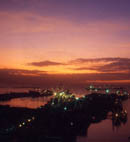
Beautiful Manila Bay, wasn't always that way | | 
The author's schooner anchored at Corregidor | | 
Old Manila was a walled city before the war | | 
Then came the Japanese invasion | | 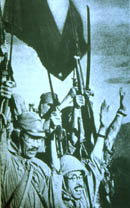
The surrender of Corregidor | | 
The Cross on Bataan Peninsula | | 
The Cross close up | | 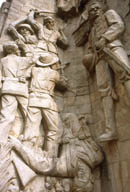
Sculptures depicting then war | | 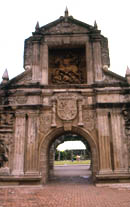
The Intramuros Gate | | 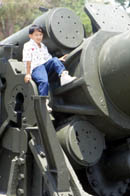
Big guns but couldn't stop the Japanese | | 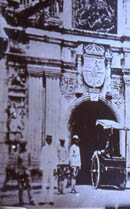
The gate as it once was | | 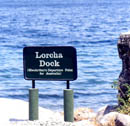
The dock from which MacArthur was evacuated | | 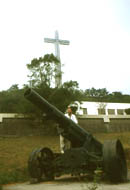
A cannon and the cross | | 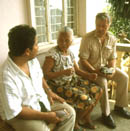
The author interviews an elderly lady who remembers | | 
Much to photograph | | 
Where soldiers died kids now play | | 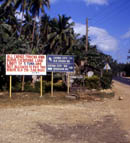
The road that was once a Death March | | 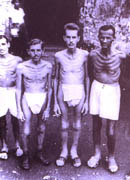
Some prisoners survived, but barely | | 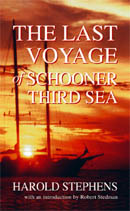
The author's The Last Voyage recaptures the war in the Philippines | | 
Next week we visit the old capital of Siam |
|





